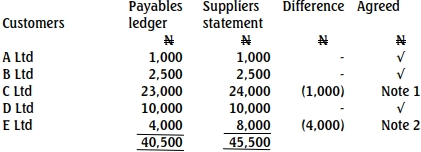Adeco Nigeria plc is a large and diversified company with several factories. One of its factories that produces “Apex” has not been able to meet its sales target for over two years. The board has mandated the company’s management to take a decisive step on what to do with the factory.
The management, therefore, set up a committee of three—the factory manager, marketing manager, and the management accountant—to analyze the situation and come up with a report on what the management should do. The marketing manager submitted two proposals to the committee, which are:
- Proposal 1: A sales volume of 25,000 units can be achieved with a selling price of ₦13.50 per unit and an advertising campaign costing ₦37,500.
- Proposal 2: A sales volume of 35,000 units can be achieved at a selling price of ₦11.25 per unit with an advertising campaign costing ₦52,500.
The management accountant is to work on these proposals with the information provided by the factory manager and come up with calculations to help the committee know which of the proposals to recommend to management. The management accountant is also required to prepare a third scenario that would reflect the factory’s closure.
The factory manager provided the following information:
| Budgeted Sales and Production of Apex (Units) |
50,000 |
| Sales |
₦750.0 |
| Less production costs: |
|
| Material A – 1 kg per unit |
₦75.0 |
| Material B – 1 litre per unit |
₦37.5 |
| Labour – 1 hour per unit |
₦187.5 |
| Variable overhead |
₦150.0 |
| Fixed overhead |
₦75.0 |
| Non-production costs |
₦75.0 |
| Total cost |
₦600.0 |
| Budgeted profit |
₦150.0 |
The following additional information has also been made available:
(i) There are 50,000 kg of material A in inventory. This originally cost ₦1.5 per
kg.
Material A has no other use and unless it is used by the division, it would have
to be disposed off at a cost of ₦750 for every 5,000 kg.
(ii) There are 30,000 litres of material B in inventory. Any unused material can be
used by another department to substitute for an equivalent amount of a
material, which currently costs ₦1.875 per litre. The original cost of material B
was ₦0.75 per litre and it can be replaced at a cost of ₦2.25 per litre.
(iii) All production labour hours are paid on an hourly basis. Rumours of the
closure of the department have led to a large proportion of the department‟s
employees leaving the organisation. Uncertainty over its closure has also
resulted in management not replacing these employees. The department is
therefore short of labour hours but has sufficient man hour to produce 25,000
units. Output in excess of 25,000 units would require the department to hire
contract labour at a cost of ₦5.625 per hour. If the department is shut down,
the present labour force will be deployed within the organisation.
(iv) Included in the variable overhead is the depreciation of the only machine
used in the department. The original cost of the machine was ₦300,000 and it
is estimated to have a life span of 10 years. Depreciation is calculated on a
straight-line basis. The machine has a current resale value of ₦37,500. If the
machinery is used for production, it is estimated that the resale value of the
machinery will fall at the rate of ₦150 per 1,000 units produced. All other
costs included in variable overhead vary with the number of units produced
(v) Included in the fixed production overhead is the salary of the factory manager
which amounts to ₦30,000. If the department were to shut down, the
manager would be made redundant with a redundancy pay of ₦37,500. All
other costs included in the fixed production overhead are general factory
overheads and will not be affected by any decision concerning the factory.
(vi) The non-production cost charged to the factory is an apportionment of the
total on-production costs incurred by the factory.
The committee will be meeting in a week‟s time to prepare its report to the
management on what course of action the management should take, either one of
the marketing manager‟s proposals or to close down the factory.
Required:
As the management accountant of Adeco Plc, you are to:
a. Prepare detail calculations to support the committee‟s recommendation to
the management whether to:
i. reduce production to 25,000 units
ii. reduce production to 35,000 units
iii. shut down the factory. (20 Marks)
b. A customer has just placed a special order for 25,000 of Apex and the
customer is willing to pay ₦12.00 per unit. Advise management whether to
accept or reject the order. Assume that for any shortfall in material “A”
required to produce the order, it can be bought at a price of ₦2.00 per kg.
(10 Marks)
c. Discuss the management accounting techniques and principles that a
management accountant will apply in preparing calculations to support
management decision in such a circumstance as above. (10 Marks)


